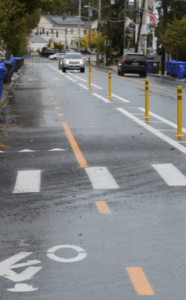by The Cowl Editor on October 24, 2019
News

by Max Waite ’21
News Staff
Upon moving back on campus this semester, students were greeted by a drastic change on nearby Eaton Street.
As part of the “Great Streets Initiative,” Providence Mayor Jorge Elorza approved of 60 plus miles of bike lanes scattered throughout the city of Providence. Eaton Street was the first street to be reconstructed.
The construction was finished the week of Sept. 9, adding a double bike lane on the side of the street. Lieutenant Eric Croce from the Office of Public Safety described the repaving process by saying, “It was like it happened overnight.”
While the construction project seemed to sneak up on locals nearby, it ended up being short-lived. The construction received backlash from those who live in the area surrounding Eaton Street, who were also surprised by the project.
According to Steve Maurano, associate vice president of public affairs, community & government relations, the repaving process of the .75-mile bike lane could be restored to its original condition as early as Monday, October 21. It cost $63,500 to construct, while the repaving process will cost $64,000.
Last month, there were two community meetings that were held at St. Pius School as a result of the double bike lane. Council members in attendance for the first meeting were David Salvatore, Jo-Ann Ryan, and Katherine Kerwin representing Wards 14, 5, and 12.
Many locals in attendance found the project to be rushed and not well thought out. Some locals actually thought that Providence College wanted the bike lane. But this decision was entirely the city’s, and the overall consensus was that a bike lane is not a bad concept, but the city should have looked for more community input on the abrupt project.
Locals are not too happy about the taxes they are going to have to pay as a result of the failed project either. Ultimately, it was a common theme that Eaton Street was the worst location to premiere the city’s widespread bike lane initiative.
A couple of years ago, Maurano got a group of faculty members together who all enjoyed riding bicycles to discuss the use of “jump bikes” around the Elmhurst area. Maurano said that faculty members were “supportive of the concept, but the streets in the area were not equipped to handle bicyclists.”
To add to the project’s overwhelming sense of haste, there were many factors that the city did not take into account.
Maurano went on a ride-along with Lieutenant John Dunbar from the Office of Public Safety to experience the changes on the road. According to Maurano, there were a couple of spots on their drive where tree trunks nearly took off the side mirror on the public safety truck as a result of the incredibly narrow road. One could only imagine the difficulties that drivers would face in even bigger vehicles.
Additionally, the lanes were so narrow that other cars veer into the opposite lanes and face head-on with traffic. When turning onto Eaton Street, drivers have to go all the way into the other lane in order to make a proper turn, as well.
Though these dangerous instances are just a couple of examples as to why the double bike lane was not thought through, Maurano expresses several more concerns in a letter that he sent to the city of Providence while construction was underway.
Among issues addressed in the letter included trash pickups for PC off-campus residents living on Eaton Street as well as snow removal. Both of these concerns are crucial because the yellow poles between the lanes prevent these jobs from effectively being accomplished without difficulty.
With these concerns in mind, think about who would be using this double bike lane. It seems evident that the lane was not used nearly as much as the city anticipated, and that is most likely because the lane is not even a mile long.
If someone is an avid bicyclist, or even just wants to go out on a ride, they most likely will want to ride longer than three-quarters of a mile. Once the Eaton Street lane ends, there are not any connecting bike lanes in the area anyway.
Many streets in Providence have the potential to feature a bike lane, but it was quickly proven that Eaton Street is not on that list.